List of the Top 3 onion omega 2+ dock you can buy in 2022
When you want to find onion omega 2+ dock, you may need to consider between many choices. Finding the best onion omega 2+ dock is not an easy task. In this post, we create a very short list about top 3 the best onion omega 2+ dock for you. You can check detail product features, product specifications and also our voting for each product. Let’s start with following top 3 onion omega 2+ dock:
| Product | Features | Editor's score | Go to site |
|---|---|---|---|

|
Onion Omega2+ & Arduino Dock 2 Bundle |
|
Go to amazon.com |

|
Onion Arduino Dock 2 for Omega2 |
|
Go to amazon.com |

|
Onion Omega Power Dock 2 |
|
Go to amazon.com |
1. Onion Omega2+ & Arduino Dock 2 Bundle
Feature
580MHz MIPS CPU, 128MB Memory, 32MB Onboard Storage, 2.4GHz b/g/n WiFiLinux Operating System with support for many programming languages
ATmega328P microcontroller co-processor that can be wirelessly programmed using the Arduino IDE
All microcontroller pins accessible and arranged in same pattern as on the Arduino Uno
Expansion Header provides access to Omega's USB2.0, UART, I2C, SPI, 12 GPIOs and supports Omega Expansions
Description
The Omega2+ IoT computer is Onion's Linux-based, WiFi development board designed to enable makers of all skill levels to build connected hardware applications. Plug in your Omega into the Dock, provide power, and it will boot the operating system right away, allowing you to develop in your favorite programming language, create web applications, and interface with a variety of hardware with minimal time and effort spent getting started. The Arduino Dock 2 features the ATmega328P microcontroller that's also found on the Arduino Uno R3. It can be wirelessly programmed by the Omega using the Arduino IDE. The Omega and microcontroller can communicate with a serial UART as well as I2C. The microcontroller's pins are all broken out just like on the Arduino Uno, allowing use of all Arduino Shields. The Omega's GPIOs are broken out on the Expansion Header; use them to control external circuits or connect plug and play Omega Expansions. Also supports connecting USB devices to the Omega. At the Omega2+'s core is the MT7688 SoC that features a 580 MHz MIPS CPU, supports 2.4 GHz IEEE 802.11 b/g/n WiFi as well as 10M/100M wired ethernet network connectivity, and operates at 3.3V. The Omega2+ comes with 128MB of DDR2 DRAM memory and 32MB of on-board flash storage, double that of the Omega2! The Omega was built to interact with other hardware, so it has a wide variety of hardware interfaces. It has dedicated pins for USB2.0 and Ethernet as well as 12 GPIO pins that can be controlled by the user. These GPIOs can support the I2C, UART, and SPI serial communication protocols. Rich documentation, tutorials, and projects available at Onion's official site.2. Onion Arduino Dock 2 for Omega2
Feature
Features an ATmega328P microcontroller coprocessor that connects to the OmegaAll microcontroller pins accessible and arranged in same pattern as on the Arduino Uno
Expansion Header provides access to Omega's USB2.0, UART, I2C, SPI, 12 GPIOs and supports Omega Expansions
Program the microcontroller wirelessly using the Arduino IDE with the Omega
Serial UART and I2C communication between the Omega and microcontroller
Description
Supercharge your projects by combining the familiar Arduino platform with the power & connectivity of the Omega2. The Arduino Dock 2 features the ATmega328P microcontroller as a coprocessor, that's the same microcontroller used on the Arduino Uno R3. The microcontroller pinout is the same as on the Arduino Uno enabling the reuse of all existing Arudino Shields. Because of the Omega's wireless capabilities, the microcontroller can be programmed wirelessly using the Arduino IDE. Communication between the Omega and microcontroller can be achieved through a serial UART connection as well as the I2C bus. Provide power with any Micro USB cable and the Dock will safely power the Omega and microcontroller. The Omega's GPIOs are exposed on the Expansion Header, use the Expansion Header to connect Onion Omega Expansions or control other external devices and circuits. Connect USB devices directly to the Omega with the on-board USB Type-A connector. Rich documentation, tutorials, and projects available at Onion's official site.3. Onion Omega Power Dock 2



Recent Comments